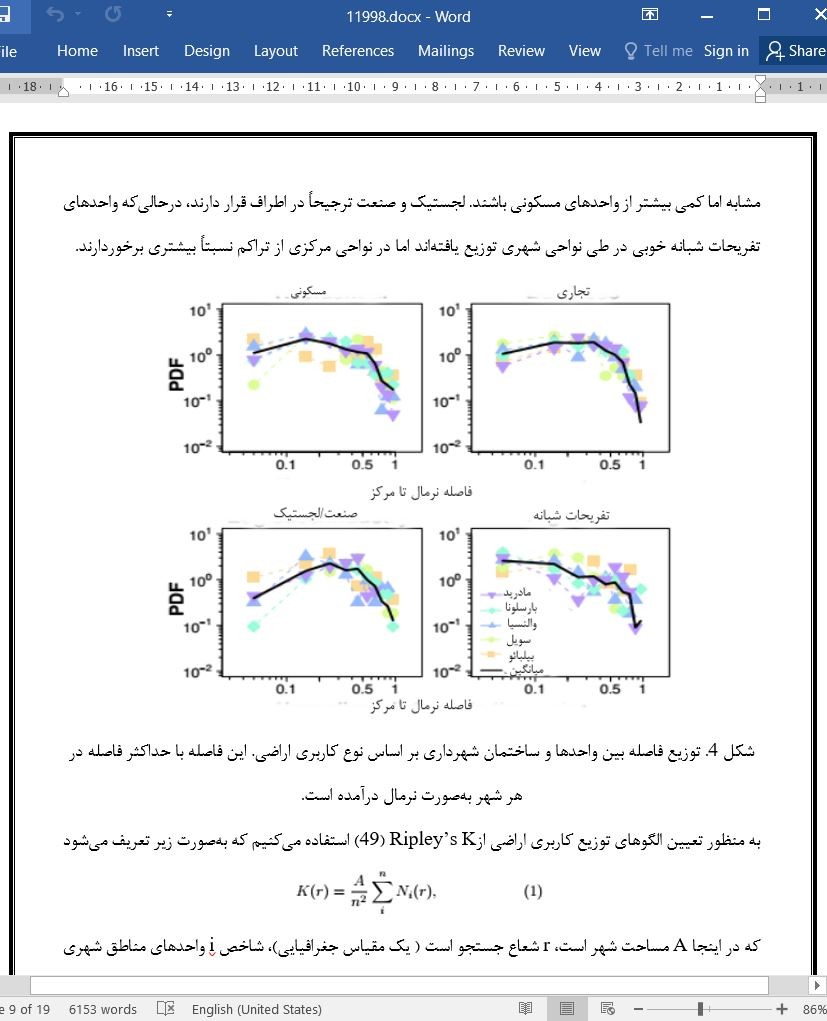
مقایسه و مدل سازی سازمان دهی کاربری اراضی در شهرها
ظهور فنآوریهای اطلاعات و ارتباطات با مکانیابی جغرافیایی، امکان بررسی نحوه استفادۀ مردم از فضا را در شهرها میسر میسازد و ابزار جدید و مهمی را برای دانشمندان و برنامه ریزان شهری بخصوص در مناطقی که اطلاعات کمی در مورد آن وجود دارد و یا هیچ اطلاعاتی در مورد آن در دسترس نیست، به ارمغان میآورد. در اینجا، ما از یک رویکرد شبکهای کاربردی برای تعیین الگوهای کاربری اراضی از سوابق تلفن همراه استفاده میکنیم. تطبیقپذیری این روش به ما این امکان را میدهد که یک مقایسه سیستماتیک را بین شهرهای اسپانیا در اندازههای مختلف انجام دهیم. این روش چهار نوع مختلف کاربری اراضی را نشان میدهد که به الگوهای زمانی مختلفی مربوط میشوند. نسبت هر یک از اینها، سازماندهی و مقیاس فضایی آنها، شباهت زیادی را بین همه شهرهایی که در مقیاسهای محلی تقسیمبندی میشوند نشان میدهد که در آن کاربری اراضی مختلط به هر ناحیه شهری اختصاص دارد. در پایان با الهام از مدل تفکیک Schelling مدلی را ارائه میدهیم که میتواند این نتایج را با قوانین تعامل ساده بین استفاده از اراضی مختلف توضیح دهد و تکرار نماید.
مقدمه
به نظر میرسد که الگوهای کاربری اراضی، بهطور طبیعی از تعامل شهروندان و برنامه ریزان با فضای شهری حاصل شده باشد. بااینحال، در یک حلقه بازخورد، آنها در تجربهای که ساکنان و بازدیدکنندگان از یک شهر دارند نیز نقش مهمی ایفا میکنند (1). الگوهای کاربری اراضی بر قابل سکنی بودن نواحی مجاور و حتی سلامت ساکنان محلی تأثیر دارد (2). از سوی دیگر، رابطه بین کاربری اراضی و حملونقل، یک رابطه موثق را نشان میدهند (3-6). تقاضای حملونقل، به محل سکونت و حوزههای کسبوکار بستگی دارد، درحالیکه وجود خطوط یا سرویسهای جدید حملونقل مانند ایستگاه مترو میتواند بهطور قابلملاحظهای اختلاط کاربری اراضی را در یک منطقه خاص از شهر تغییر دهد. این ایدهها از توسعه مدلهای به اصطلاح تعامل حملونقل - کاربری اراضی (LUTI)(7،8) که عموماً در برنامهریزی حملونقل در سراسر جهان بکار گرفته میشوند، ناشی میشوند (9).
The advent of geolocated ICT technologies opens the possibility of exploring how people use space in cities, bringing an important new tool for urban scientists and planners, especially for regions where data is scarce or not available. Here we apply a functional network approach to determine land use patterns from mobile phone records. The versatility of the method allows us to run a systematic comparison between Spanish cities of various sizes. The method detects four major land use types that correspond to different temporal patterns. The proportion of these types, their spatial organization and scaling show a strong similarity between all cities that breaks down at a very local scale, where land use mixing is specific to each urban area. Finally, we introduce a model inspired by Schelling’s segregation, able to explain and reproduce these results with simple interaction rules between different land uses.
INTRODUCTION
Land use patterns appear as a natural result of citizens’ and planners’ interaction with the urban space. However, in a feedback loop, they also play a major role in the experience that residents and visitors have of a city [1]. Land use patterns have an effect on the liveability of neighborhoods and even on the health of the local residents [2]. On the other hand, land use and transportation display a well-established relation [3–6]. Transport demand depends on the location of residence and business areas, while the presence of new transport lines or facilities such as metro stations can substantially modify the land use mixing in a given area of the city. These ideas lie behind the development of the so-called Land Use Transport Interaction (LUTI) models [7, 8], which are commonly employed in transport planning around the globe [9].
مقدمه
موضوعات و روشها
یک رویکرد شبکهای برای تشخیص کاربری اراضی
نتایج
مقایسه شهرها
مدلسازی کاربری اراضی
اختلاط انواع کاربری اراضی
بحث
منابع
INTRODUCTION
MATERIALS AND METHODS
A network approach to detect land use
RESULTS
Comparison of cities
Modeling land use
Mixing of land use types
DISCUSSION
References
APPENDIX
- ترجمه فارسی مقاله با فرمت ورد (word) با قابلیت ویرایش، بدون آرم سایت ای ترجمه
- ترجمه فارسی مقاله با فرمت pdf، بدون آرم سایت ای ترجمه



